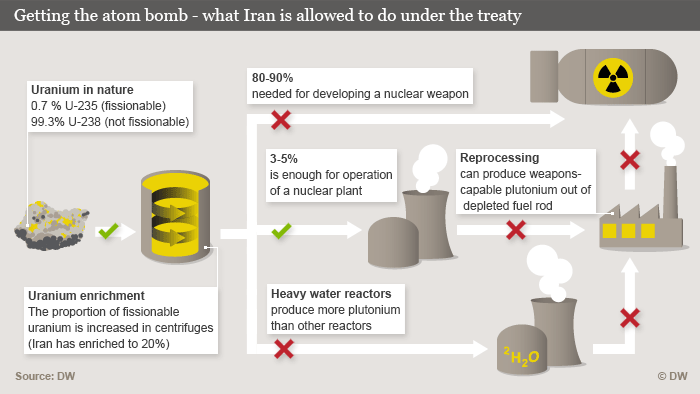An atomic bomb can be made from two types of radioactive materials: uranium or plutonium. The talks were aimed at curbing Iran’s ability to put these two elements to use in weapons. In each case, the manufacturing starts with uranium ore.
Uranium mined from the earth is less than 1 percent U-235, the isotope that can be used to fuel reactors and make bombs. Centrifuges are needed to separate the U-235 from the rest of the uranium, in a process called enrichment. The other fuel that can be used to make a bomb, plutonium, is made by irradiating uranium in a nuclear reactor. The process transforms some of the uranium into plutonium.
Curbing the Uranium Path
During the enrichment process, centrifuges are used to raise concentrations of U-235. For most power reactors in the West, uranium is enriched up to 5 percent. Bomb grade is above 90 percent and Iran had been processing ore to 20 percent enrichment.
The agreementIran has agreed to transform its deeply buried plant at Fordo into a center for science research. Another uranium plant, Natanz, is to be cut back rather than shut down. Some 5,000 centrifuges for enriching uranium will remain spinning there, about half the current number. Iran has also agreed to limit enrichment to 3.7 percent and to cap its stockpile of low-enriched uranium at 300 kilograms, or 660 pounds, for 15 years. That is considered insufficient for a bomb rush.
Curbing the Plutonium Path
Iran was constructing a nuclear reactor at Arak that would have used natural uranium to produce Pu-239, which can fuel bombs.
The agreementIran has agreed to redesign and rebuild the Arak reactor so it will not produce weapons-grade plutonium. The original core of the reactor, which would enable the production of weapons-grade plutonium, will be made inoperable, but will stay in the country. Under the terms of the deal, the reactor’s spent fuel, which could also be used to produce a bomb, will be shipped out of the country. Iran will not build any additional heavy water reactors for 15 years.
Key Issues
How to Ensure That Iran Won’t Cheat
More than twice the size of Texas in area, Iran poses many challenges for atomic inspectors who have to police the agreement and gain access not only to scientists, labs and factories, but also to many underground sites and military bases. Western allies say the new inspections must be far more intrusive than those in the past, given the deal’s sweeping terms as well as Iran’s history of evasions, stonewalling and illicit procurements. The principal concerns are how to detect cheating and covert sites.
The agreement: Iran has agreed to provide the International Atomic Energy Agency greater access and information regarding its nuclear program, and to allow the agency to investigate suspicious sites or allegations of covert facilities related to uranium enrichment anywhere in the country. Inspectors will also have access to the supply chain that supports Iran’s nuclear program, including uranium mines and mills, and to continuous surveillance of centrifuge manufacturing and storage facilities.
What Is the Timeline of the Agreement?
The deal requires Iran to reduce its current stockpile of low-enriched uranium by 98 percent, and limits Iran’s enrichment capacity and research and development for 15 years. Some inspections and transparency measures will remain in place for as long as 25 years. According to President Obama: “This relief will be phased in. Iran must complete key nuclear steps before it begins to receive sanctions relief.” Sanctions for arms could be lifted in five years, ballistic missiles in eight.
Extending the Breakout Time
The agreement increases the “breakout” time — the amount of time it would take Iran to produce enough bomb-grade material for a singular nuclear weapon — to at least one year.
Source: NY Times/DW































